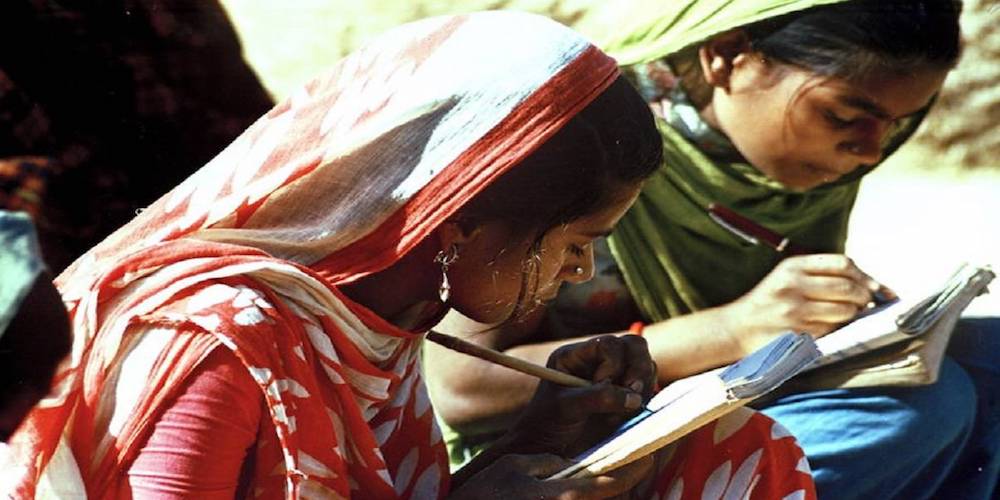New India Literacy Programme

The central government led by Prime Minister Narendra Modi has announced a Centrally Sponsored Scheme namely, “New India Literacy Programme” (NILP) for implementation during five years from 2022-23 to 2026-27.
The programme aims at covering a target of 5.00 crore learners during the five years under the Foundational Literacy and Numeracy component. The programme has five objectives: (i) Foundational Literacy and Numeracy, (ii) Critical Life Skills, (iii) Vocational Skills Development, (iv) Basic Education and (v) Continuing Education.
However, the major challenge faced by the Government while implementing the NILP presently is the opening and mapping of all Bank Accounts of Single Nodal Agencies (SNAs) and Implementing Agencies (IAs) in all States with Public Financial Management System (PFMS), admits Minister of State for Education, Smt. Annpurna Devi. Because, as she explains, this is a pre-requisite for release of funds as per revised procedure guidelines of the Ministry of Finance, says . The challenge exists because this is the first year of implementation.
The total financial outlay of NILP for five years (FYs 2022-23 to 2026-27) is Rs.1037.90 crore, out of which Rs.700 crore is Central share and Rs.337.90 crore is State share. The Central and State shares are in the ratio of 60:40 for all States other than North Eastern Region (NER) and Himalayan States where the sharing pattern between the Centre and the State is in the ratio of 90:10. For UTs with legislature the ratio is 60:40, except in the UT of Jammu & Kashmir where the ratio is 90:10, and for all other UTs without legislature the Central share is 100%.The fund flow is through PFMS and State treasuries.
Various steps are being taken by the Government for effective implementation of the programme in the country and encouraging users to join the programme including Andaman and Nicobar Islands.
The first step is to identify the beneficiaries and Volunteer Teachers. Survey of beneficiaries and Volunteer Teachers (VTs) are being conducted by States/UTs using schools as the base. The volunteer teachers are trained to carry out the learning modules in online mode. Various workshops are being conducted by States/UTs.
At national level, the content is driven by the Cell for National Centre for Literacy (CNCL) at National Council of Educational Research and Training (NCERT). The teaching and learning material is available on DIKSHA portal developed by NCERT. The sample assessment modules have also been made available on DIKSHA.
All States/UTs have been sensitized through communication dated 11th March, 2022 along with a roadmap for implementation of the programme for conducting, among others, environment building activities by the involvement and use of social media platforms including Print/Electronic/Folk Media and Interpersonal Media to reach across the country including all rural areas and to create an atmosphere so as to motivate and spur potential literacy volunteers and learners and also to adopt multiple strategies, keeping in view the local conditions, with active participation of community leaders, PRI functionaries, Mahila Mandals, Civil Society Organisation and educational institutions.
Meanwhile, the Department of School Education and Literacy with effect from 2018-19 has launched an Integrated Centrally Sponsored Scheme for School Education- Samagra Shiksha . The scheme has now been aligned with the recommendations of NEP 2020 to ensure that all children have access to quality education with an equitable and inclusive classroom environment which should take care of their diverse background, multilingual needs, different academic abilities and make them active participants in the learning process.
The major objectives of the Scheme are: (i) Support States and UTs in implementing the recommendations of the National Education Policy 2020 (NEP 2020); (ii) Support States in implementation of Right of Children to Free and Compulsory Education (RTE) Act, 2009; (iii) Focus on Early Childhood Care and Education; (iv) Emphasis on Foundational Literacy and Numeracy; (v) Thrust on Holistic, Integrated, Inclusive and activity based Curriculum and Pedagogy to impart 21st century skills among the students; (vi) Provision of quality education and enhancing learning outcomes of students; (vii) Bridging Social and Gender Gaps in School Education; (viii) Ensuring equity and inclusion at all levels of school education; (ix) Strengthening and up-gradation of State Councils for Educational Research and Training (SCERTs)/State Institutes of Education and District Institutes for Education and Training (DIET) as nodal agency for teacher training; (x) Ensuring safe, secure and conducive learning environment and maintenance of standards in schooling provisions and (xi) Promoting vocational education.
Under Samagra Shiksha, various interventions have been targeted for girls, which include opening of schools in the neighbourhood to make access easier for girls, free uniform and text-books to girls up to Class VIII, additional teachers and residential quarters for teachers in remote/hilly areas, appointment of additional teachers including women teachers, stipend to CWSN girls from class I to class XII , separate toilets for girls, teachers’ sensitization programmes to promote girls participation, gender-sensitive teaching-learning materials including text books etc.
Further, under Samagra Shiksha, special state specific projects for varied interventions under equity are emphasized for enhancing access, retention and quality for girls by promoting enrolment drives, retention and motivation camps, gender sensitization modules etc. Such projects include life skills, awareness programmes, incinerators, sanitary pad vending machines etc.
To reduce gender gaps at all levels of school education, there is a provision of Kasturba Gandhi Balika Vidyalayas (KGBVs) under Samagra Shiksha. KGBVs are residential schools from class VI to XII for girls belonging to disadvantaged groups such as SC, ST, OBC, Minority and Below Poverty Line (BPL). The KGBVs are set up in Educationally Backward Blocks (EBBs) of a State/UT where the female rural literacy rate is below the national average. Under Samagra Shiksha, provision has been made to upgrade/converge the KGBVs/Girls’ Hostel, as feasible, up to senior secondary level.
As far as the public financing by the Central Government is concerned, the Budget Estimate under Samagra Shiksha during 2022-23 is Rs. 37383.36 crore, an increase of 20.40% from revised estimate of Rs. 31050.15 crore of year 2021-22.



